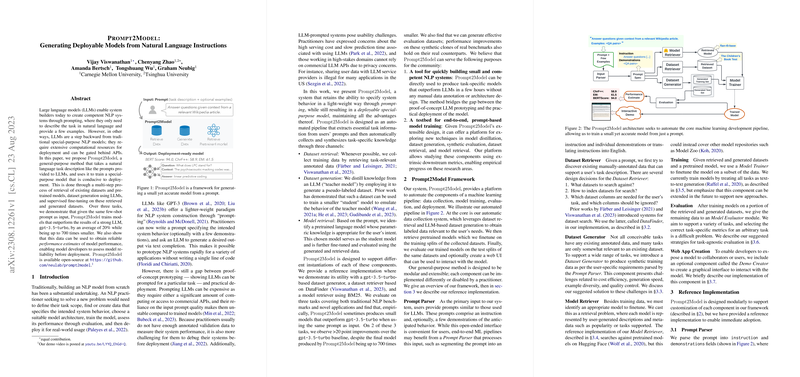Overview of "Prompt2Model: Generating Deployable Models from Natural Language Instructions"
The paper "Prompt2Model: Generating Deployable Models from Natural Language Instructions" presents a novel framework for training special-purpose NLP models using natural language prompts. The key motivation behind this work is to bridge the gap between the powerful, but resource-intensive, LLMs like GPT-3.5-turbo and the need for smaller, deployable models that can be adapted to specific tasks without extensive computational demands.
Key Contributions
The authors identify several challenges with the current LLM-based approaches for NLP system building, such as extensive computational resources, dependency on commercial APIs, instability due to prompt quality, and lack of annotated validation data for model reliability assessment. To address these challenges, the authors propose Prompt2Model, an automated pipeline that can generate high-performing, task-specific models from natural language instructions. The key components of this pipeline include:
- Dataset Retrieval: Leveraging existing annotated datasets that are relevant to the user's prompt to minimize the need for manual data labeling.
- Dataset Generation: Employing an LLM to create synthetic data that can be used to train smaller models.
- Model Retrieval: Identifying suitable pretrained models based on the task description, which are then fine-tuned on the collected and generated datasets.
Experimental Evaluation
The paper evaluates Prompt2Model on three distinct tasks to demonstrate its utility:
- Machine Reading Question Answering: Using SQuAD as a benchmark, Prompt2Model achieved an Exact Match (EM) score of 61.5, significantly outperforming GPT-3.5-turbo, which scored 42.1.
- Japanese NL-to-Code Generation: Evaluated using the MCoNaLa dataset, Prompt2Model showed weaker performance than GPT-3.5-turbo, highlighting challenges in handling low-resource languages.
- Temporal Expression Normalization: Here, Prompt2Model achieved a ChrF++ score of 55.2, outperforming GPT-3.5-turbo's 30.7.
These results indicate that Prompt2Model can produce models that are not only smaller (up to 700 times smaller than GPT-3.5-turbo) but also outperform LLMs in certain tasks, particularly when the prompt and task are well-aligned with available pretraining data.
Implications and Future Research Directions
The Prompt2Model framework offers significant practical and theoretical implications. Practically, it reduces the barrier to deploying high-quality NLP models by automating the data collection and model training process. Theoretically, it opens avenues for further research in model distillation, dataset generation, synthetic evaluation, and dataset and model retrieval.
Practical Implications
- Cost-Effective Model Deployment: By significantly reducing the size of the models, Prompt2Model makes NLP technology more accessible for applications with limited computational resources.
- High Customizability: The framework allows users to tailor models to their specific needs without extensive expertise in data annotation or model training.
Theoretical Implications
- Enhanced Understanding of Model Distillation: The effective use of synthetic datasets generated by LLMs to train smaller models invites more research into optimizing data generation techniques.
- Synthetic Evaluation Techniques: The ability to reliably estimate model performance using generated datasets could revolutionize model evaluation methodologies, particularly in low-resource settings.
Discussion
The authors acknowledge some limitations, such as reliance on proprietary APIs and challenges with low-resource languages. Future work could explore integrating open-source LLMs to provide a more accessible framework. Additionally, expanding the language capabilities of the system and refining the data generation processes could address some of the current challenges.
The extensible and modular design of Prompt2Model also makes it a compelling platform for future research. By allowing individual components to be customized or replaced, the framework can serve as a testing ground for new techniques in various aspects of automated machine learning.
In conclusion, Prompt2Model presents a significant step towards making NLP models more accessible and deployable, reducing reliance on computationally intensive LLMs while maintaining, and in some cases exceeding, their performance levels. This work not only addresses a critical need in the deployment of NLP systems but also sets the stage for future innovations in automated machine learning pipelines.
